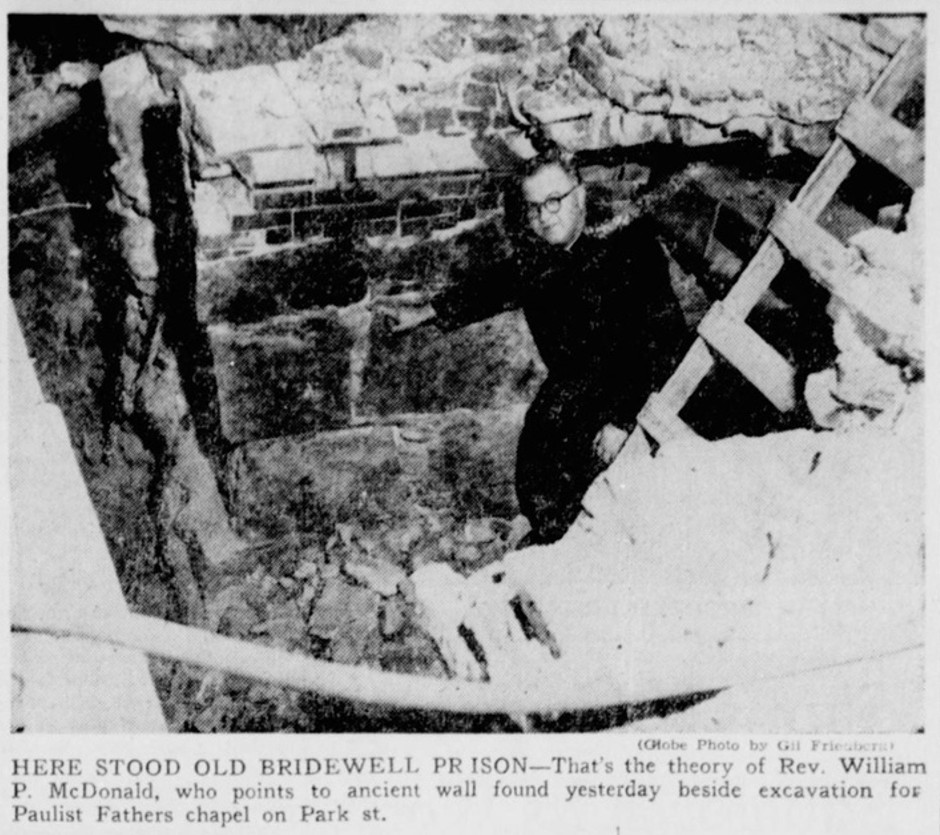Built in 1723, Bridewell Prison was a prison built next to the almshouse that once existed near the intersection of Beacon and Park Streets in Boston, Massachusetts.
Many cities across the world had a Bridewell, which was a type of English correctional facility invented in the 16th century that served as a combination of a workhouse and a prison.
The almshouse in Boston was first constructed in the 1660s, but it was later destroyed by a fire and rebuilt in 1696. The Bridewell prison was added to the site in 1723, as well as a separate workhouse in 1739.
In 1795, the Almshouse, Bridewell prison, and workhouse were sold for redevelopment, and a new almshouse was built near present-day Causeway Street.
It is not exactly known what happened to the original almshouse, prison, and workhouse after the fact, but it is believed that they were demolished and replaced with new buildings.
Then, on August 28, 1956, the dungeon of the Bridewell prison was uncovered during construction on the Paulist Center, a Catholic church located at 5 Park Street.
According to a news report in the Boston Daily Globe at the time, two cell-like rooms and an old fireplace were discovered under the east sidewalk of Park Street when the Paulist Center began constructing the Paulist Fathers chapel on Park Street.
The dungeon featured one large eight-foot by six-foot cell surrounded by a wall of hand-cut heavy granite stone. Next to this large cell was a smaller one about eight feet deep and four feet wide.
Connecting the two cells was a small corridor, which had a small arched opening in it that may have been a fireplace. This fireplace was deep and ran under the Park Street sidewalk almost to the street. It was about 36 inches wide and 50 inches tall.
Reverend William P. McDonald, fund drive director for the center, said that workers uncovered the dungeon when they discovered seven granite steps leading down to that level the previous March during construction.
The following month, the workers also discovered a 150-year-old stable and a series of tunnels that led to Boston Common. Workers also found five 8,000-gallon cisterns, full of something that looked like water.
The discovery of the old prison didn’t come as a complete surprise to Reverend McDonald because he had been informed ahead of time by historians, who were aware that the location was once the site of the almshouse and prison, that he might find the remnants of the old prison when the Paulist Center began construction.
When other newspapers at the time learned of the discovery, they ran headlines that it was an old “Witch Prison” that once held witches and pirates. Yet, since the prison wasn’t built until the 18th century and only for the use of the almshouse, it is unlikely that it held either accused witches or pirates.
The news reports also incorrectly stated that the prison was built in 1665. Although the almshouse was first built around 1665, the prison itself wasn’t constructed on the site until 1723.
The Paulist Center’s website confirms that the Holy Spirit Chapel was built on the site in the mid-1950s but doesn’t mention the Bridewell prison or the history of the site.
When reached for comment, Sam Whooley at the Paulist Center said that no evidence of the prison currently exists at the Paulist Center:
“I could not find any visible or physical evidence of a jail or prison at the Paulist site,” Whooley said. “There are no visible remains of the old Bridewell prison, nor are there any tours of it, at the site where the Paulist Center and ‘The Chapel of the Holy Spirit’ now stand.”
Whooley also said he was unaware that these ruins were found underneath the center in 1956, but he found it very intriguing to learn about it.
“I found your question very interesting—it sent me down the ‘Old Bridewell prison’ rabbit hole!” Whooley said.
Sources:
“Workmen Unearth What is Believed Bridewell Prison.” The Telegraph-Herald, 29 Aug. 1956, p. 41.
“1665 Prison Apparently Found Under Park Street.” Boston Globe, 29 Aug. 1956, p. 1.
“Workmen Unearth Ruins Of Old Boston Prison.” Washington Evening Journal, 29 Aug. 1956, p.1.
“Boston Workers Uncover Bridewell Prison Dungeons.” Newburyport Daily News, 30 Aug. 1956, p. 12.
“Witch Prison Believed Found by Excavators.” Meridan Journal, 30 Aug. 1956, p. 10.
“Workmen Unearth Boston’s Famed Bridewell Prison.” Clinton Daily Item, 29 Aug. 1956, p.1.
“Paulists Discover Apparent Remains of Colonial Prison.” The Witness, 13 Sept. 1956, p. 11.
“Workers Find Pilgrim Prison on Paulist Site.” The Catholic Times, 14 Sept. 1956, p. 7.
“The Boston Almshouse.” Primary Research, primaryresearch.org/the-boston-almshouse/
“The Almshouse and Workhouse.” Colonial Society of Massachusetts, colonialsociety.org/node/3085
“The Leverett Street Almshouse.” West End Museum, thewestendmuseum.org/history/era/west-boston/the-leverett-street-almshouse/
“Why are there so many bridewells?” Prison History, prisonhistory.org/2021/09/why-are-there-so-many-bridewells/
“Our History.” The Paulist Center, paulistcenter.org/our-history/

